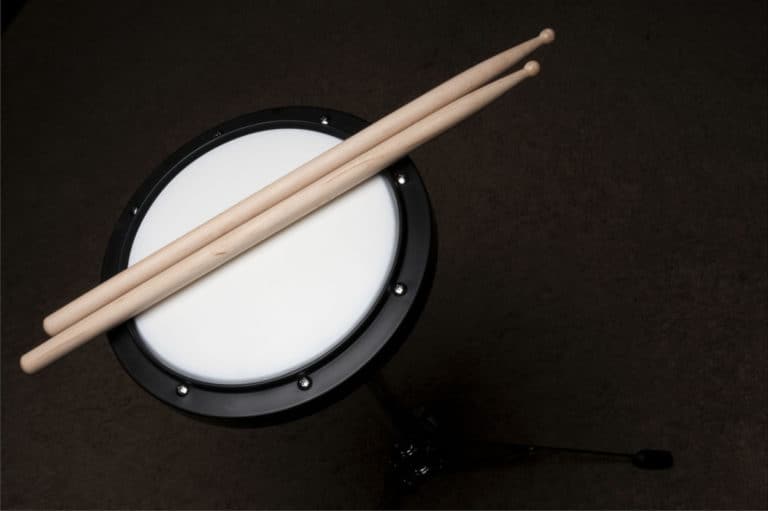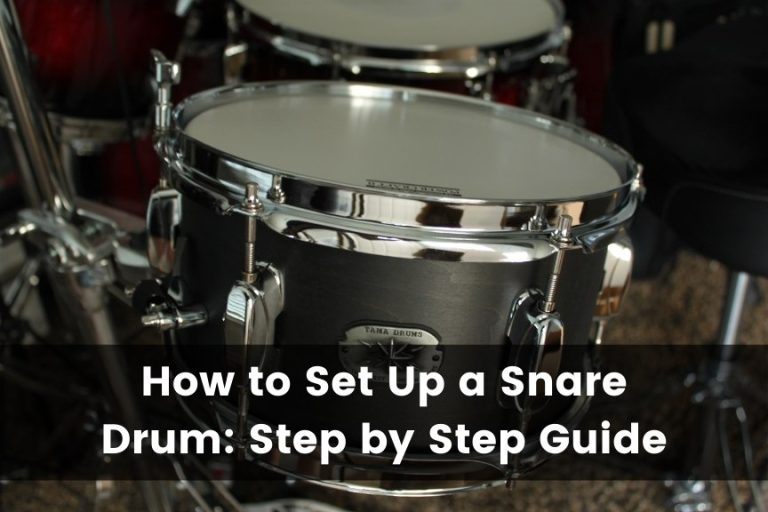How To Make Drums Sound Better (10 Simple Tips)
For all musicians out there, one of the greatest feelings – aside from perfecting a new song or technique – is getting new gear, specifically a new drum set. However, nothing crushes that feeling faster than your drums not sounding as good as what you expected them to, and you’re left wondering, “What can I do to make my drums sound better?”
There are many viable, cost-effective ways to make your drums sound better. Whether your drum kit is brand new or has been used and isn’t sounding as good as it should, several options like tuning your drums, replacing your drum heads, or muffling your drums can do wonders for your kit.
If your drum kit is not sounding as good as you had hoped, do not make the mistake of thinking that there is nothing that you can do but sell it and save for a new one. You’re likely to encounter the same or similar issues if you go that route. Take the time to get hands-on with your drum kit and take it from sounding average to excellent with a few simple tweaks.
The Importance Of Great Sounding Drums
It is fair to say that every drummer – and every musician – feels a surge of inspiration when the equipment you are playing with sounds great. Indeed, even if there is no science behind it, something about great-sounding drums makes you play better – perhaps it just adds motivation to spend more time practicing.
On the other hand, when your drums are not lining up with the sound that you have in your head and ultimately not sounding as good or resonating how you had hoped, you can quickly feel frustrated and, in many cases, totally demotivated. An essential aspect of the expression of music is having a sound that matches the uniqueness of the musician.
To the untrained ear, drums create nothing but noise. However, it is the very expression of their musical skill, taste, and nature for a drummer. A drummer who is unsatisfied with their drum kit’s sound is no different from a guitarist who is unsatisfied with their guitar tone. You get the picture, right?
Thankfully, as is the case with most other instruments, a few tweaks and adjustments ranging from minor to significant will have a profound effect on the overall sound and feel of your drums. The great news is you will be able to do most of it by yourself too, and, depending on the severity, you won’t need to spend a lot of money.
How To Make Drums Sound Better
Alright, let’s go over ten simple ways to make your drums sound better and take you from feeling frustrated and demotivated to excited and full of inspiration. Note that a few of these steps – while mostly affordable or free – might require you to invest some of your money, but hopefully, you will be able to avoid that.
Tighten All Of Your Hardware
A rattling drum kit is undoubtedly one of the most frustrating things to deal with, and without proper education, it can leave you frustrated without a clue on how to resolve the issue. You will be pleased to know if you are struggling with a rattling sound on your drum kit, you should be able to fix it quickly with just a few tools.
Usually, most of the hardware on drums – specifically where the screws are – have washers attached to them. If any of these screws are slightly loose, you will undoubtedly be dealing with an audible rattle. Take a screwdriver and, if necessary, a pair of pliers, and tighten all of the screws on your hardware, especially those used to attach the hardware to your drum’s shells.
Of course, you might be tempted to overtighten, which is also something that you want to avoid, as you could negatively impact the resonance of your drum shells and also risk stripping the screws and needing to replace them. Tightening to a moderate friction point should do the trick and eliminate any annoying rattling.
There is also hardware inside your drum shells, so if the previous step hasn’t helped fully, you will want to check inside your shells. However, note that this will require removing your drum heads, which we will cover in the coming steps.
Tune Your Drums
One of the most technical aspects of drum kit maintenance is learning how to tune your drum kit properly. Indeed, there truly is somewhat of an art to effective tuning. Drums that are not properly tuned can sound terrible – to put it bluntly. If you have never tuned your drums before, this could be the cause of an unsatisfactory drum sound.
Most experienced drummers have learned to tune their drums by ear. However, if you are not yet at that level, there are tools like a drum dial that can help you with tuning and several online tutorials that can be of great help.
However, learning to tune drums properly takes time and experience, so there is no shame in getting professional assistance if you are having trouble with this. Getting your drums tuned will revolutionize the sound of your drum kit, and your ears will undoubtedly thank you for it.
Get New Drum Heads
If tuning your drums isn’t improving your kit’s overall sound the way you thought it would, then the issue might be a little more severe. Drums are designed to take a beating. However, as with anything that you repeatedly hit, they will inevitably need some TLC.
The drum heads fitted on factory drum kits are not the best quality in many cases. If you are about to buy a new drum kit, it would be worthwhile budgeting a little extra money to put some good quality drum heads on your kit. Since drum heads are the part where you make contact with your sticks, you can understand how important they are in your overall drum sound.
If the drum heads on your kit have been on there for a while now, freshening up your kit with some new drum heads will undoubtedly bring your kit back to life. The resonance of drum heads has a limited lifespan, so even if they aren’t overly visibly damaged or worn, it is likely that old drum heads won’t resonate as well, ultimately affecting your drum sound.
Make sure to purchase the correct size drum heads for your drum kit. If you are not sure of the measurements off hand, use a tape measure to find out the diameter of the actual drum shells. If you are still not feeling confident, don’t worry. Take your shells to your nearest drum store for one of the professionals to assist you with the perfect size.
Check Your Snare Wire
Sure, snare wire is typically more durable than other drum kit parts since you are not hitting them directly. However, time and continued use can cause snare wire to ware out or get damaged and ultimately prevent you from having an excellent snare tone.
Take a closer look at your snare wire, particularly with your snare throw-off in the off position. If you notice any bent, damaged, or even missing wires, it is unquestionably time to replace your snare wire.
Different snare wires play a significant role in the type of drum sound that you can expect to have. The best thing that you could do is go to your local drum shop and ask the professionals which snare wire will be best suited to the drum tone you are going for.
Drum Muffling
Drum muffling is undoubtedly one of the most common modifications that almost every drummer has attempted or regularly applied to their drum kit. Drums are designed to resonate – that’s ultimately what gives them their sound. However, drums can often resonate more than what’s necessary, making them sound “boomy” and less focused.
Strategic muffling is a great way to get your drums to sound the way you want them to, and there are many ways – including some DIY methods – to help you get the job done.
Undoubtedly, the most popular form of drum muffling is sticking a pillow or a blanket inside of the kick (bass) drum. This will significantly alter the sound of your kick drum for the better. Your kick drum will sound a lot tighter and punchier, removing that uncontrolled “boom.”
For toms and snares, using some gaffer tape to attach some Kleenex to the drum head is an easy and cost-effective way to dampen the sound of your drums, once again giving them a more controlled and focused sound. However, this option is not the classiest looking one out there and can make it look like your drums have been injured and needed plaster.
If you would like a sound dampening option that looks far more professional, tone rings – also known as O-rings – make a great addition to any drum kit. Tone rings are thin plastic rings that do an excellent job controlling the overall ring and resonance of your toms and snare drum.
Add A Hole/Port To Your Bass Drum
A tip to specifically improve the sound of your kick drum is to add a hole/port to the front of the kick drum. Note that if you are not particularly handy with these modifications, outsourcing the job to a professional is highly recommended.
There are a few benefits to adding a port to your kick drum. The first is that kick drum ports allow sufficient air to escape when the beater makes contact with the drum. This will ultimately improve the overall resonance of your kick drum, giving it a punchier type of sound.
The other benefit has to do with recording. Having a port on the front of your kick drum enables a microphone to be placed there without removing the drum head from the front of the kick drum.
Check Your Cymbal Mountings
This is a relatively simple tip to try out. Ensuring that your cymbals are properly mounted will make them sound as best as possible. Cymbals require a decent amount of felt to resonate at their best. The overall angle of the cymbals, and ultimately your playing technique, can also positively and negatively affect the tone of your cymbals.
Buy Good Quality Cymbals
Unfortunately, there isn’t much that anyone could do to make bad-quality cymbals sound any better. If you have already done all that you can to improve the tone of your cymbals, but they are still sounding dull and lifeless, then your best bet will be to invest in some good-quality cymbals.
Unfortunately, this is where you will need to spend the most money because if you have ever looked at cymbals at your local drum shop, you would have noticed that they often have a seriously high price tag attached to them. In the case of cymbals, you really do get what you pay for. A higher price almost always indicates higher quality.
One of the best things to improve your drum kit’s sound is to invest in high-quality cymbals. This will truly bring your drum kit to life and take your drum sound to a whole new level.
Change Your Drumsticks
Another option to try is changing the kind of drumsticks you are using. Drumstick types are a highly subjective and personal aspect of playing drums, so your best bet is to try out as many types as possible.
Size is one thing, but the most noticeable difference will be found in the tips of your sticks. Wood or nylon tips are your only options, yet they each produce a vastly different sound. Nylon tips will give you a much brighter sound – most noticeably on your cymbals – while wood tips will provide a warmer, more traditional sound.
Neither is technically better; you will need to find what your preference is.
Sound Treating Your Drum Room
As a final resort, one thing to consider is that you might not need to change or tweak anything on your drums themselves. The room you play your drums in can have a significant effect on how the drums resonate. Room to room, your drums could sound different.
A simple method is to get a carpet for your room that you can place your drums on. In more extreme cases, you might want to invest in some acoustic foam panels to treat your room for excess reverb. This can drastically change how your drums sound and should help get your drums sounding great again.
Conclusion
Thankfully, there are many ways to improve the sound of your drums and help you get back to feeling inspired again. Hopefully, the easy and cost-effective solutions will do the trick for you. However, investing in the quality and improvement of your drum sound will also be highly rewarding and will not leave you disappointed.







